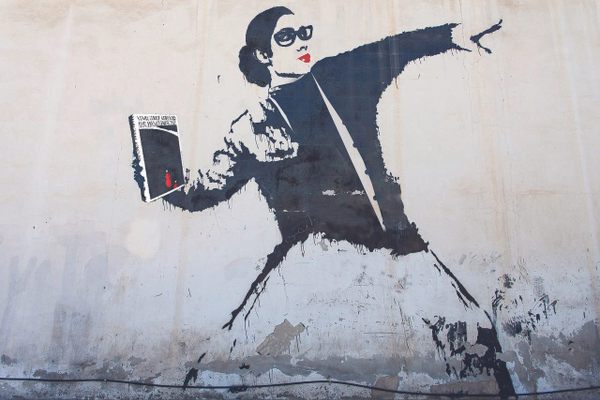8 Surprising Stories to Celebrate World Book Day
The pleasures of reading about reading.
To mark World Book Day 2023—an annual celebration of the written word hosted by UNESCO each April 23— we’ve hunted through the Atlas Obscura archives for our favorite stories about stories. Read on for tales of bookmakers, booksellers, book collectors, book thieves, and more. Plus, check out our ultimate list of the world’s most wondrous bookstores.
How German Librarians Finally Caught an Elusive Book Thief
by Jeffrey Arlo Brown
On the afternoon of February 21, 2006, Norbert Schild sat down at a desk in the reading room of the City Library of Trier, in western Germany, and opened a 400-year-old book on European geography. Working quickly, he laid a piece of blank white paper on top of the book, took a boxcutter from his lap, and discreetly sliced out a map of Alsace from pages 375 and 376. Schild had been doing this for decades: Often using a fake identity, he stole countless antique maps worth thousands of dollars each. This time, two librarians were watching.
Keeping the Centuries-Old Tradition of Venetian Bookbinding Alive
by Vittorio Traverso
The first thing one notices upon approaching Paolo Olbi’s bookstore from Ca’ Foscari bridge in Venice is the intricate patterns and vibrant colors. His carefully displayed selection of handmade books, notebooks, and stationery look like an old postcard. Olbi himself, an impeccably dressed and groomed 78-year-old native Venetian, is as much a caretaker as an artisan. He’s been making books since he was 18. When he started, there were 20 traditional bookbinding shops in Venice. Today, he is one of just three.

The Only Bookstore on Najafi Street
by Pesha Magid
Tucked into an alleyway off Najafi Street in Mosul’s Old City is a small red and gold sign advertising a bookstore: Maktaba al-Sham. Not long ago, it was one of countless bookstores along the wide avenue lined with arched windows and doorways. Since the early 1900s the street has been a bustling cultural hub where intellectuals meet to sip tea, debate friends, and buy books. But in the aftermath of ISIS occupation, the street lay in ruins, and four years after the Iraqi city’s liberation, Daud Salim was the first—and only—bookseller to return to the storied street.
The Strange and Grotesque Doodles in the Margins of Medieval Books
by Anika Burgess
From intriguingly detailed illustrations to random doodles, the drawings and other marks made along the edges of pages in medieval manuscripts—called marginalia—are not just peripheral matters. “Both tell us huge amounts about a book’s history and the people who have contributed to it, from creation to the present day,” says Johanna Green, Lecturer in Book History and Digital Humanities at the University of Glasgow. And some of them are downright weird.


The Women Who Rode Miles on Horseback to Deliver Library Books
by Anika Burgess
They were known as the “book women.” They would saddle up, usually at dawn, to pick their way along snowy hillsides and through muddy creeks with a simple goal: to deliver reading material to Kentucky’s isolated mountain communities. The book women rode 100 to 120 miles a week, on their own horses or mules, along designated routes, regardless of the weather. And by the end of 1938, there were 274 librarians riding out across 29 counties.
How Soviet Children’s Books Became Collectors’ Items in India
by Divya Sreedharan
For Indians who grew up in the late 1970s, 80s, and 90s, love of Soviet-era literature is an unexpected binding force. Translated books from the Soviet Union were readily available and extremely affordable via book fairs and exhibitions staged by local distributors and book houses in both India’s small towns and its bigger cities. “These books lit up our childhood,” says book collector Devadatta Rajadhyaksha. “At that time, we didn’t know they were from the Soviet Union, but their format and design made them irresistible.”

Can Science Solve the Mystery of the Concrete Book?
by April White, Senior Editor/Writer
The slab of concrete is more than a foot tall, 10 inches wide, and two inches thick. It weighs about 20 pounds, and it is cataloged in the University of Chicago’s library system as a book. This unusual tome, titled Betonbuch (Concrete Book), was “published” in Zurich, Switzerland, in 1971 by experimental artist Wolf Vostell. He claimed he encased a 26-page booklet in concrete. But Patti Gibbons, head of collections management for the Hanna Holborn Gray Special Collections Research Center, began to wonder: “Was this a prank, or is this for real?”
The Ultimate Guide to Wondrous Independent Bookstores
by Jonathan Carey, Senior Associate Editor, Places
Some things never change, technology be damned. Books can be downloaded and read on your phone or other device, or listened to in the car, but nothing beats walking into a bookstore. Here are 53 of our favorite independent bookstores around the world from the streets of Paris, to William Faulkner’s former home in New Orleans, to a one-time bomb shelter in China.























































Follow us on Twitter to get the latest on the world's hidden wonders.
Like us on Facebook to get the latest on the world's hidden wonders.
Follow us on Twitter Like us on Facebook